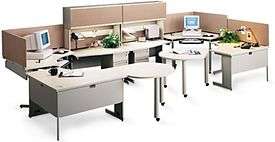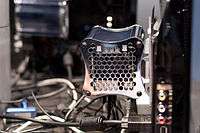Modular design
Modular design, or "modularity in design", is a design approach that subdivides a system into smaller parts called modules or skids, that can be independently created and then used in different systems. A modular system can be characterized by functional partitioning into discrete scalable, reusable modules; rigorous use of well-defined modular interfaces; and making use of industry standards for interfaces.
Besides reduction in cost (due to less customization, and shorter learning time), and flexibility in design, modularity offers other benefits such as augmentation (adding new solution by merely plugging in a new module), and exclusion. Examples of modular systems are cars, computers, process systems, solar panels and wind turbines, elevators and modular buildings. Earlier examples include furniture, looms, railroad signaling systems, telephone exchanges, pipe organs, synthesizers and electric power distribution systems. Evolution also results in the modular design of species in that homologous modules sharing approximately the same form or function appear in different organisms.[1] Computers use modularity to overcome changing customer demands and to make the manufacturing process more adaptive to change (see modular programming).[2] Modular design is an attempt to combine the advantages of standardization (high volume normally equals low manufacturing costs) with those of customization. A downside to modularity (and this depends on the extent of modularity) is that low quality modular systems are not optimized for performance. This is usually due to the cost of putting up interfaces between modules.[3]
In vehicles

Aspects of modular design can be seen in cars or other vehicles to the extent of there being certain parts to the car that can be added or removed without altering the rest of the car.
A simple example of modular design in cars is the fact that, while many cars come as a basic model, paying extra will allow for "snap in" upgrades such as a more powerful engine or seasonal tires; these do not require any change to other units of the car such as the chassis, steering, electric motor or battery systems.
In machines and architecture
Modular design can be seen in certain buildings. Modular buildings (and also modular homes) generally consist of universal parts (or modules) that are manufactured in a factory and then shipped to a build site where they are assembled into a variety of arrangements.[4]
Modular buildings can be added to or reduced in size by adding or removing certain components. This can be done without altering larger portions of the building. Modular buildings can also undergo changes in functionality using the same process of adding or removing components.

For example, an office building can be built using modular parts such as walls, frames, doors, ceilings, and windows. The interior can then be partitioned (or divided) with more walls and furnished with desks, computers, and whatever else is needed for a functioning workspace. If the office needs to be expanded or redivided to accommodate employees, modular components such as wall panels can be added or relocated to make the necessary changes without altering the whole building. Later, this same office can be broken down and rearranged to form a retail space, conference hall or another type of building, using the same modular components that originally formed the office building. The new building can then be refurnished with whatever items are needed to carry out its desired functions.
Other types of modular buildings that are offered from a company like Allied Modular include a guardhouse, machine enclosure, press box, conference room, two-story building, clean room and many more applications.[5]
Many misconceptions are held regarding modular buildings.[6] In reality modular construction is a viable method of construction for quick turnaround and fast growing companies. Industries that would benefit from this include healthcare, commercial, retail, military, and multi-family/student housing.
In televisions
In 1963 Motorola introduced the first rectangular color picture tube, and in 1967 introduced the modular Quasar brand. In 1964 it opened its first research and development branch outside of the United States, in Israel under the management of Moses Basin. In 1974 Motorola sold its television business to the Japan-based Matsushita, the parent company of Panasonic.
In computer hardware

Modular design in computer hardware is the same as in other things (e.g. cars, refrigerators, and furniture). The idea is to build computers with easily replaceable parts that use standardized interfaces. This technique allows a user to upgrade certain aspects of the computer easily without having to buy another computer altogether. This idea was also being implemented in Project Ara, which provided a platform for manufactures to create modules for a smartphone which could then be customised by the end user.
A computer is one of the best examples of modular design. Typical modules include power supply units, processors, mainboards, graphics cards, hard drives, and optical drives. All of these parts should be easily interchangeable as long as the user uses parts that support the same standard interface. Similar to the computer's modularity, other tools have been developed to leverage modular design, such as littleBits Electronics, which snap together with interoperable modules to create circuits.[7]
Modular Design, Digital Twin, and Industry 4.0 directions
During the presentation of the PLM centre of University of Michigan, Grieves[8] launched inside the modular design contest the initial idea of "Conceptual ideal for PLM", that introduces: real space, virtual space, the link for data flow from real space to virtual space, the link for information flow from virtual space to real space and virtual sub-spaces. Egan [9](PTC Inc) disclosed the strategy for an implementation of modular design in a PLM (Product Lifecycle Management) contest through a process that starts with a cross-functional input to the definition of the product architecture, and includes an architecture development program that keeps the integrity of the product during its lifecycle. Grieves [10]has produced an effective definition of digital twin: “A strategic business approach that applies a consistent set of business solutions in support of the collaborative creation, management, dissemination, and use of product definition information across the extended enterprise from concept to end of life –integrating people, processes, business systems, and information”.
Integrating Lifecycle and Energy assessments into modular design
Some authors observe that modular design has generated in the vehicle industry a constant increase of weight over time. Trancossi [11] advanced the hypothesis that modular design can be coupled by some optimization criteria derived from the constructal law. In fact, the constructal law is modular for his nature and can apply with interesting results in engineering simple systems.[12] It applies with a typical bottom-up optimization schema:
- a system can be divided into subsystems (elemental parts) using tree models;
- any complex system can be represented in a modular way and it is possible to describe how different physical magnitudes flow through the system;
- analysing the different flowpaths it is possible to identify the critical components that affect the performance of the system;
- by optimizing those components and substituting them with more performing ones, it is possible to improve the performances of the system.
A better formulation has been produced during the MAAT EU FP7 Project.[13] A new design method that couples the above bottom-up optimization with a preliminary system level top-down design has been formulated.[14] The two step design process has been motivated by considering that constructal and modular design does not refer to any objective to be reached in the design process. A theoretical formulation has been provided in a recent paper,[15] and applied with success to the design of a small aircraft,[16] the conceptual design of innovative commuter aircraft,[17][18] the design of a new entropic wall,[19] and an innovative off-road vehicle designed for energy efficiency.[20]
See also
| Look up beam in Wiktionary, the free dictionary. |
References
- ↑ Schilling, M.A. (2002) Modularity in multiple disciplines. In Garud, R., Langlois, R., & Kumaraswamy, A. (eds) Managing in the Modular Age: Architectures, Networks and Organizations. Oxford, England: Blackwell Publishers, pg. 203-214 ISBN 0631233164
- ↑ Baldwin and Clark, 2000
- ↑ Ulrich K (1995) The role of product architecture in the manufacturing firm. Res Policy 24(3):419–441. doi:10.1016/0048-7333(94)00775-3, 1995
- ↑ "Modular home definition". Retrieved 2010-08-19.
- ↑ Allied Modular Products Allied Modular. Retrieved March 27, 2012
- ↑ "modular building". Archived from the original on 2014-09-17.
- ↑ "How One Entrepreneur Is Bringing Fringe Maker Knowledge Mainstream". PSFK. PSFK. Retrieved 27 May 2015.
- ↑ Grieves, M. (2005). “Product Lifecycle Management: the new paradigm for enterprises.” Int. J. Product development 2, 71-84
- ↑ Egan, M. (2004). “Implementing A Successful Modular Design-PTC´s Approach.” In Proceedings of the 7th Workshop on Product Structuring - Product Platform Development, Chalmers University, Göteborg, Sweden, 24.-25.03. 2004.
- ↑ Grieves, M. (2006), “Product Lifecycle Management, Driving the Next Generation of Lean Thinking”, New York, McGraw-Hill
- ↑ Trancossi, M. A response to industrial maturity and energetic issues: a possible solution based on constructal law. Eur. Transp. Res. Rev. (2015) 7: 2. doi:10.1007/s12544-014-0150-4
- ↑ Bejan A., and Lorente S., “Constructal theory of generation of configuration in nature and engineering”, J. Appl. Phys., 100, 2006, doi:10.1063/1.2221896
- ↑ http://cordis.europa.eu/project/rcn/99650_en.html
- ↑ Dumas A, Madonia M, Trancossi M, Vucinic D (2013) Propulsion of photovoltaic cruiser-feeder airships dimensioning by constructal design for efficiency method. SAE Int J Aerosp 6(1):273–285. doi:10.4271/2013-01-2303 https://www.academia.edu/download/43218871/Propulsion_of_Photovoltaic_Cruiser-Feede20160229-7290-15tzf2r.pdf
- ↑ Trancossi, M. Eur. Transp. Res. Rev. (2015) 7: 2. doi:10.1007/s12544-014-0150-4 https://link.springer.com/article/10.1007/s12544-014-0150-4
- ↑ Trancossi, M., Bingham, C., Capuani, A., Das, S. et al., "Multifunctional Unmanned Reconnaissance Aircraft for Low-Speed and STOL Operations," SAE Technical Paper 2015-01-2465, 2015, doi:10.4271/2015-01-2465. https://www.academia.edu/download/39296132/2015-01-2465.pdf
- ↑ Trancossi, M., Madonia, M., Dumas, A. et al. Eur. Transp. Res. Rev. (2016) 8: 11. doi:10.1007/s12544-016-0198-4 https://www.researchgate.net/publication/297890415_A_new_aircraft_architecture_based_on_the_ACHEON_Coanda_effect_nozzle_flight_model_and_energy_evaluation
- ↑ Trancossi, M., Dumas, A., Madonia, M., Subhash, M. et al., "Preliminary Implementation Study of ACHEON Thrust and Vector Electrical Propulsion on a STOL Light Utility Aircraft," SAE Technical Paper 2015-01-2422, 2015, doi:10.4271/2015-01-2422. https://www.researchgate.net/publication/300470359_Preliminary_Implementation_Study_of_ACHEON_Thrust_and_Vector_Electrical_Propulsion_on_a_STOL_Light_Utility_Aircraft?ev=prf_pub
- ↑ TRANCOSSI, M., et al. Constructal Design of an Entropic Wall With Circulating Water Inside. Journal of Heat Transfer, 2016, 138.8: 082801. https://www.researchgate.net/publication/301779272_Constructal_Design_of_an_Entropic_Wall_With_Circulating_Water_Inside
- ↑ Trancossi M., Pascoa J, Design of an Innovative Off Road Hybrid Vehicle by Energy Efficiency Criteria, International Journal of Heat and Technology, 2016. https://www.researchgate.net/publication/309732623_Design_of_an_Innovative_Off_Road_Hybrid_Vehicle_by_Energy_Efficiency_Criteria?ev=prf_pub
Further reading
- Schilling, MA., "Toward a general modular systems theory and its application to interfirm product modularity" Academy of Management Review, 2000, Vol 25(2):312-334.
- Erixon, O.G. and Ericsson, A., "Controlling Design Variants" USA: Society of Manufacturing Engineers 1999 ISBN 0-87263-514-7
- Clark, K.B. and Baldwin, C.Y., "Design Rules. Vol. 1: The Power of Modularity" Cambridge, Massachusetts: MIT Press 2000 ISBN 0-262-02466-7
- Baldwin, C.Y., Clark, K.B., "The Option Value of Modularity in Design" Harvard Business School, 2002
- Levin, Mark Sh. "Modular systems design and evaluation". Springer, 2015.
- Modularity in Design Formal Modeling & Automated Analysis
- "Modularity: upgrading to the next generation design architecture", an interview